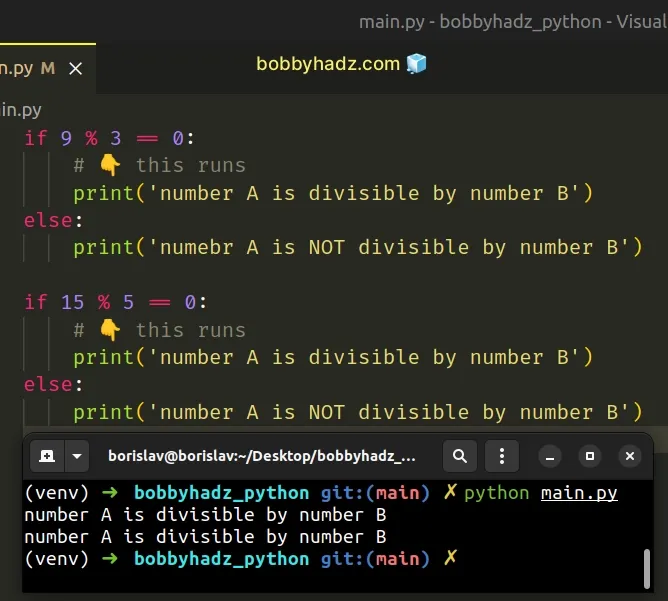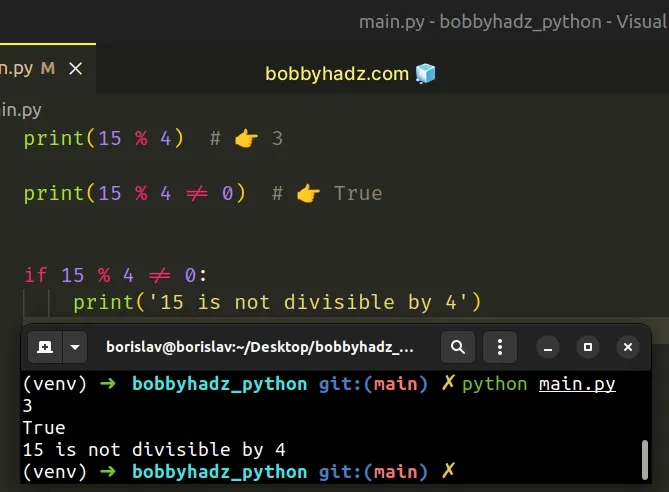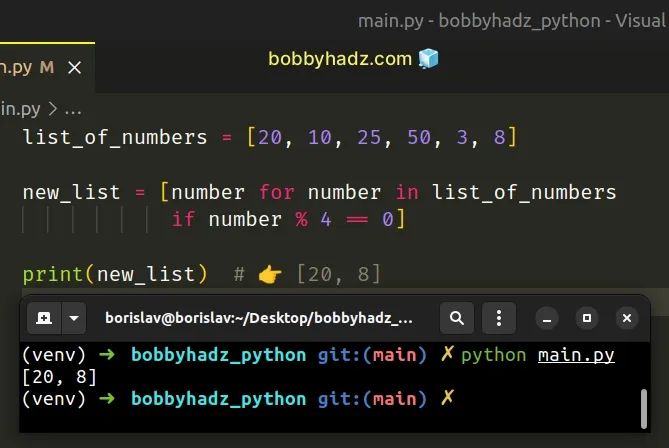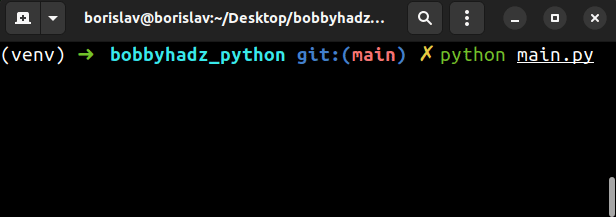Check if a number is divisible by another number in Python
Last updated: Apr 9, 2024
Reading time·4 min

# Table of Contents
- Check if a number is divisible by another number in Python
- Checking if a number is not divisible by another number
- Find the numbers in a List that are divisible by another number
- Find the numbers in a List that are divisible by another number using filter()
- Check if a Number from user input is divisible by another number
- Check if a number is divisible by two or more numbers
- Check if a number is divisible by 1 of multiple numbers
# Check if a number is divisible by another number in Python
Use the modulo % operator to check if a number is divisible by another
number.
The modulo % operator returns the remainder from the division of the first
number by the second. If the remainder is 0, the number is divisible by the
other number.
if 9 % 3 == 0: # 👇️ this runs print('number A is divisible by number B') else: print('numebr A is NOT divisible by number B') if 15 % 5 == 0: # 👇️ this runs print('number A is divisible by number B') else: print('number A is NOT divisible by number B')

We used the modulo % operator to check if a number is divisible by another
number.
The modulo (%) operator returns the remainder from the division of the first value by the second.
print(10 % 2) # 👉️ 0 print(10 % 4) # 👉️ 2
If there is no remainder from the division, then the first number is an exact multiple of the second.
print(16 % 4) # 👉️ 0 print(16 % 4 == 0) # 👉️ True
4 is an exact multiple of 16, so 16 is divisible by 4 with a remainder
of 0.
# Checking if a number is not divisible by another number
If you need to check if a number is not divisible by another number, use the
modulo % operator with the not equals != sign.
print(15 % 4) # 👉️ 3 print(15 % 4 != 0) # 👉️ True if 15 % 4 != 0: print('15 is not divisible by 4')

15 is not an exact multiple of 4, so dividing 15 by 4 gives us a
remainder of 3.
# Find the numbers in a List that are divisible by another number
To find the numbers in a list that are divisible by another number:
- Use a list comprehension to iterate over the list of numbers.
- Check if each list item is divisible by the given number using the modulo
%operator. - Return the matching items.
list_of_numbers = [20, 10, 25, 50, 3, 8] new_list = [number for number in list_of_numbers if number % 4 == 0] print(new_list) # 👉️ [20, 8]

List comprehensions are used to perform some operation for every element or select a subset of elements that meet a condition.
On each iteration, we use the modulo operator to check if the current list item
is divisible by 4 and return the result.
The new list only contains the matching elements.
# Find the numbers in a List that are divisible by another number using filter()
Alternatively, you can use the filter() function.
list_of_numbers = [20, 10, 25, 50, 3, 8] new_list = list( filter( lambda x: x % 4 == 0, list_of_numbers ) ) print(new_list) # 👉️ [20, 8]
The filter() function takes a function and an iterable as arguments and constructs an iterator from the elements of the iterable for which the function returns a truthy value.
The lambda function we passed to filter() gets called with each element from
the list.
The function checks if each element is divisible by 4 and returns the result.
The last step is to use the list() class to
convert the filter object to a list.
# Check if a Number from user input is divisible by another number
Here is an example that takes numbers from user input and checks if one number is divisible by another.
num_1 = int(input('Enter a number: ')) print(num_1) # 👉️ 16 num_2 = int(input("Enter another number: ")) print(num_2) # 👉️ 4 if num_1 % num_2 == 0: print(f'{num_1} is divisible by {num_2}') else: print(f'{num_1} is NOT divisible by {num_2}')

The input function takes an optional prompt
argument and writes it to standard output without a trailing newline.
Notice that we used the int() class to convert the input strings to integers.
Even if the user enters a number, it still gets converted to a string.
# Check if a number is divisible by two or more numbers
If you need to check if a number is divisible by two or more other numbers, use
the and operator.
num = 15 if num % 3 == 0 and num % 5 == 0: # 👇️ this runs print('15 is divisible by 3 and 5')
The expression x and y returns the value to the left if it's falsy, otherwise
the value to the right is returned.
The if block is only run if both of the conditions evaluate to True.
# Check if a number is divisible by 1 of multiple numbers
Conversely, if you need to check if a number is divisible by 1 of multiple
numbers, use the or operator.
num = 15 if num % 10 == 0 or num % 5 == 0: # 👇️ this runs print('15 is divisible by 10 or 5')
The expression x or y returns the value to the left if it's truthy, otherwise
the value to the right is returned.
If either condition evaluates to True, the if block is run.
# Additional Resources
You can learn more about the related topics by checking out the following tutorials:

